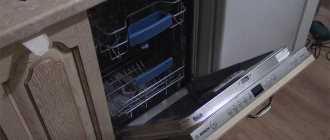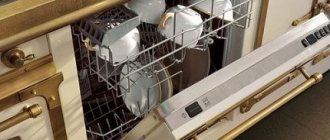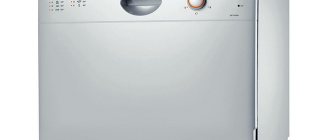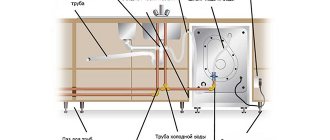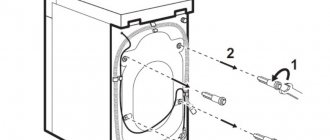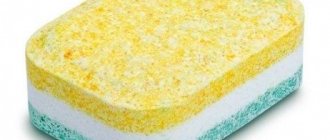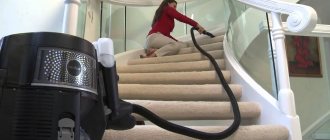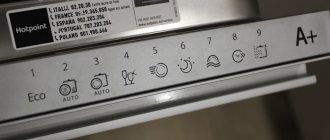Video Difficulty of repair
If you just bought a dishwasher, you will need help. If the instructions are written dryly and unclearly, from our article you will learn how to use the dishwasher correctly. As well as operating rules that will help extend the operation of equipment for many years.
What you need to know when using the dishwasher for the first time
It doesn’t matter what brand your machine is (Hansa, Bosch, Beko), the design and rules of use are similar. You need to understand where the main components and parts are located, as well as the principle of their operation:
- Camera door. When the equipment is operating, it can be locked so as not to open accidentally.
- Hopper with baskets, hooks and shelves. Dishes are placed here: plates, cups, glasses, cutlery.
- Sprayers. They can be located at the bottom and top of the chamber. Jets of water fly out from the sprinkler nozzles, washing away contaminants from the devices.
- The control panel is electromechanical, electronic, touch. For a built-in machine it is located at the end of the door, for a free-standing machine it is on the outer panel.
- The salt compartment is located next to the drain filter, at the bottom of the pan.
- Compartments and detergent dispensers are located on the door.
A special pump is responsible for circulating water in the system. The drain pump pumps out water, and the electronic board controls the work processes.
After delivering your dishwasher to your home, are you in a hurry to unpack and load the machine? Not so simple. First you need to do a test wash.
How to install and connect a dishwasher, read the article. We will remind you of the main steps:
- install the equipment in place (in a closet, niche, between cabinets); make sure the floor is perfectly level;
- connect the housing to the communications (drain and water supply);
- Connect the plug to a moisture-resistant Euro socket with mandatory RCD protection.
Now you need to run a test wash of an empty machine. This will help clean the dishwasher after transportation and storage in the warehouse, as well as check the quality of the connection.
- open the hopper door;
- remove the lower basket;
- open the salt reservoir;
- pour water into it;
- depending on the hardness of the water, add the required amount of special salt - it softens the water and removes heavy impurities;
In some models "Bosch", "Siemens", "Hansa", "Indesit" it is possible to set the degree of hardness. Adjust the position on the panel, then the equipment will take as much salt as needed.
You will know when you need to add salt by the indicator light on the panel.
Remember the basic rules after purchasing PMM:
- The equipment cannot be turned on if damage or an uneven floor surface is detected.
- The first start is idle, without dishes.
- Set to medium cycle and high temperature.
Determination of water hardness
The hardness of water is determined by the amount of metal salts dissolved in it, mainly magnesium and calcium. The more salts, the higher the hardness indicators. Excess impurities cause scale to form on the heating element and reduce the quality of washing. The delivery package for PMM Korting includes special marker strips that determine hardness indicators. After identifying them, you need to set the required level on the dishwasher.
How to load dishes correctly
Having figured out the choice of programs and launch, study the rules for arranging devices in the chamber. In PMM Electrolux (Electrolux), “Kandy”, “Beko” the location and type of baskets may be different. If you follow the instructions, everything seems simple. But the difficulty is that rarely does anyone use standard utensils. That's why:
- Clear plates of any leftover food.
- Place large utensils in the lower basket: frying pans, pots, baking trays. Place them sideways so as not to block the flow of water. It is better to place pots upside down.
- When placing plates in the holders, do not place them tightly, otherwise they will not wash off. Leave a little space.
- Place large dishes and plates on the edge, smaller cutlery in the center.
- Do not overload or place plates on top, otherwise nothing will wash off.
- Place cups and saucers in the upper basket.
- Place spoons, knives, and forks in the special cutlery compartment.
- If there is a glass holder, use it for its intended purpose.
- Make sure that large objects do not block the sprayer.
Before loading, take a look at the outside of the plate. Usually there is an acceptable washing icon.
Read about which dishes can be washed in the dishwasher in a separate article. Let's remember the main thing:
- It is prohibited to place items made of silver, earthenware, or wood into the chamber.
- Not heat-resistant plastic and glass utensils.
- Damaged items.
- Copper, tin, aluminum appliances.
This is the icon on the plates that allows you to wash them in a car:
Safety precautions
The dishwasher is a fairly safe unit. But compliance with several conditions will help you avoid possible unpleasant consequences.
- Let's repeat: wait until the cookware has cooled down before removing it from the machine.
- When installing the PMM, remember that the device must be grounded.
- In case of a malfunction, read the explanation of the error code that is shown on the device display. If you cannot fix the breakdown yourself, disconnect the machine from the power supply, turn off the tap and call a technician from the service center.
- Do not install the dishwasher near a stove or radiators.
Detergent
Choosing a cleaning product is not an easy task. You usually have to experiment before you find what's right for you. Let's look at the most popular offers:
- Tablets 3-in-1 or 7-in-1. Convenient use: do not crumble, already contain freshener and salt. According to the manufacturer, there is no need to add anything else. However, the tablet is not always convenient to use. When loading a compact dishwasher or choosing a half load, you will not be able to reduce the dose. Although some housewives cut the tablets into 2 parts (this does not apply to capsules with liquid gel).
- Powders, gels. They dissolve quickly even in short cycles, are inexpensive, and are used more economically.
- Rinse aid. Allows dishes to shine and squeak. It is poured once and for a long time until the indicator lights up.
In our other publication you will find out which dishwasher detergent is best to choose. As you understand, salt and rinse aid are added once for several cycles. Detergent must be added before each load.
Shutdown
As with loading, unloading dishes is also subject to several simple rules. As soon as the machine has completed the process and reported this on its display, do not rush to open the door, give the dishes time to cool for at least 10 minutes.
Roll out and remove dishes from the bottom tray first. The middle tray is unloaded second if there are 3 of them in the machine, and then the top one. This is due to the fact that there may be some moisture left in the trays, which will drain when pulled out and splash the dishes on the lower level.
Selecting a program in PMM
You have loaded the dishes and added the detergent. It's time to choose a washing mode, which determines how much water the equipment uses. Focus on the degree of contamination of the dishes. The stronger it is, the longer the program is better to install.
If there is not enough room for a full load of appliances, set the mode to 1/2. Then the machine will consume 30% less water and electricity.
Let's look at the main programs that are used most often:
- Daily (50-65 degrees). You can wash a variety of moderately soiled dishes.
- Delicate (30-40 degrees). For products made of fragile materials.
- Economical (50 degrees). For lightly soiled devices. Saves resources.
- Intensive (70 degrees). Helps get rid of heavy dirt and deposits.
- Machine. The system independently selects the optimal mode based on the load and degree of contamination.
If you have a model without built-in, then press the necessary keys on the external panel.
Typical breakdowns and error codes of a Siemens dishwasher
The design and principle of operation of the Siemens PMM is practically no different from other models. But some problems are especially typical for this brand.
If an error code appears on the display, look at the instructions. The manufacturer indicates the meaning of the icons.
And if you want to find out the details of solving the problem, the article “Fault codes for Siemens dishwashers” will help.
Here are the most common ones:
- E1 - water does not enter the tank.
- E7 - drying does not work.
- E9/E10 - the machine operates without heating.
- E15 - the Aquastop leakage protection has activated.
- E21/E23/E24 - water does not leave the tank, problems with the drain pump.
- E27 - incorrect network voltage.
How can you determine what is broken in the dishwasher if the code does not light up on the display? To do this, pay attention to the external manifestations of the breakdown. What users most often contact the service center with:
- The machine draws water slowly, the program freezes in the middle of the cycle . The reason may be a clogged filler path or a malfunction of the solenoid valve.
- PMM does not wash dishes well . The main problem is blockage. It is also possible that the circulation pump may break down or due to operating errors.
- The drain doesn't work . The problem is a clogged filter and a blocked pump impeller. Pump failure requires replacement.
- The program is not selected, the equipment is turned off . Problem with the electronic module.
Some problems can be solved at home. Follow our instructions below.
Tips for caring for your dishwasher
Any equipment needs care; it should not be used for wear and tear. After finishing washing, open the door and remove the dishes. Then remove the lower basket.
- Unscrew the filter in the pan and its mesh.
- Rinse the parts under pressure from the tap.
- Remove the damper and clean the impeller (no more than once a month).
The filter in the dishwasher should be cleaned after each wash or at least 2 times a month. Once every six months the machine is idled along with cleaning products.
- Leave the door open for ventilation.
- Clean rubber seals.
During operation, adhere to safety precautions:
- Do not touch the PMM body with wet hands during operation.
- Connect to a grounded outlet.
- Do not accidentally open the door, otherwise the hot jet may come into contact with your skin.
You can safely start the car.
Review of popular models
Here are the main technical characteristics of the most popular Siemens dishwashers in order to understand what to expect after purchase.
Important! When choosing a dishwashing machine, pay attention to the type of drying. Both the ease of use of the device and its initial price depend on this. Follow the link to find out "Which Type of Dishwasher Drying Is Best?"
Siemens SR 66T090:
- Control type: electronic.
- Machine type: built-in.
- Capacity - 10 sets.
- The amount of energy consumption is 780 W.
- Number of working programs - 6 (automatic, fast, economy, half load, dishwashing with pre-rinse, intensive wash).
- Energy consumption class - A++.
- Water consumption for economical washing is 9.0 liters.
- Number of temperature modes - 5.
- The duration of the economical program is 3 hours 5 minutes.
- Noise level - 44 dB.
The machine is equipped with the Aquastop system, which protects against water leakage. There is also a child lock function and a system for uniform dissolution of detergent. Using the Aquasensor sensor, the purity of the water is monitored. The machine automatically determines the type of detergent. The device is equipped with self-cleaning and filtration systems.
Siemens SR 64E002RU:
- Control type: electronic.
- Machine type: built-in.
- Capacity - 9 sets.
- The amount of energy consumption is 780 W.
- Number of working programs - 4 (automatic, fast, intensive, economy).
- Energy class - A.
- Water consumption for economical washing is 9.0 liters.
- Number of temperature modes - 5.
- Noise level - 48 dB.
The machine is equipped with a condensation dryer and a pre-rinse function for dishes. There is an indicator indicating the presence of rinse aid and salt. There is protection against children and against leaks. At the end of the dishwashing cycle, a sound signal sounds.
Important! The dishwasher comes with special tablets containing detergent.
Siemens SR 26Т897RU:
- Control type: mechanical.
- The type of machine is free-standing.
- Energy class - A.
- Power consumption - 910 W.
- The number of programs is 6, of which 3 are automatic.
- Capacity - 10 sets.
- Water consumption - 9.0 l.
- Noise level - 43 dB.
This Siemens dishwasher is small in size and has excellent functionality. There are partial load and pre-rinse modes. It is possible to reduce the duration of the program.
Siemens SR 65М035RU:
- Control type: electronic.
- Machine type: built-in.
- Capacity - 9 sets.
- The amount of energy consumption is 720 W.
- Number of working programs - 5.
- Energy class - A.
- Water consumption for economical washing is 8.0 liters.
- Number of temperature modes - 4.
- Noise level - 46 dB.
There is protection against children, against water leakage, and a half-load function. The height of the loading basket can be adjusted. There is a timer that allows you to delay washing dishes from 1 to 24 hours.
Important! This model of Siemens dishwasher has a beautiful wood-effect design, so it goes very well with kitchen furniture made of natural wood.
First run order
Carefully inspect the internal surfaces of the device, remove unnecessary stickers from them, remove packaging spacers and pieces of wire, foam balls.
Important! Before test running the device, you must open the water, otherwise the washing program will not start.
Never allow the machine to come into contact with wet hands. Also, carry out the test run only indoors, never outdoors.
Attention! Test washing of the unit does not yet indicate that it must be carried out without detergent ingredients. Detergents and salt are required during the first run.
At the beginning of the test, it is necessary to determine what is preferable to use for washing: liquid gel powder or tablets. Using the buttons on the control panel of the device, you need to set the position of which product is used.
If you have had no experience in operating such a device before, and do not have the skills to use household chemicals, then it makes sense to purchase a starter kit. It consists of the required ingredients for the full operation of the device. Now you can start the test run:
